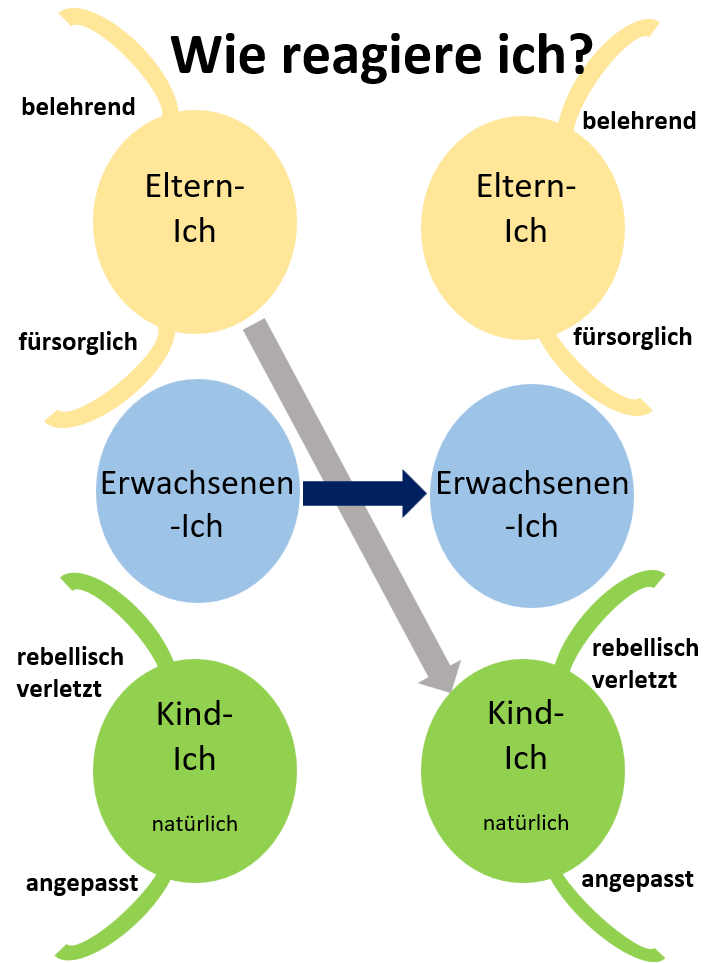Transactional Analysis: An Introduction
Transactional analysis is a model for analyzing communication. Transactional analysis can be used to determine why communication works or fails.

Transaction
A transaction is the combination of a transactional stimulus and a transactional response. The transaction stimulus is the opening of the transaction - someone says something. The transactional response is the response to the given stimulus - the interlocutor responds.

The Me-States
Transactional analysis provides three me-states in which the interlocutor can find themselves. However - and this is the problem - it often happens that the interlocutors are not in communicatively compatible me-states and the communication therefore does not take place on the same level.
Parent-Me
The parent-me comes in two forms:
1. Instructive
The pronouncement of do's, don'ts and reproaches is characteristic of the instructive parent-me. If the interlocutor is in the instructive parent-me, the statements often have a “top down” effect, demotivating, restricting, dominating.
2. Caring
Characteristic of the caring parent-me is the supportive, protective, nurturing. This condition also includes mothering and overmothering.
Adult-Me
The adult-me is factual, weighing (e.g. risk), analyzing. Objectivity is brought (back) into the conversation with the adult-me and balance is created with the other me-states.
Child-Me
The child-me stands for impulsiveness, naturalness and spontaneity. The child-me comes in the following forms:
1. Rebellious / Hurt
Characteristic of the rebellious/hurt child-me is victimization and/or defiant reactions and resistance.
2. Adjusted
The adjusted child shows itself through conformity. It behaves as expected of it, subordinates itself.
Complementary Transaction
A transaction is a complementary transaction if it has both a transactional stimulus and a transactional response
- Happening from the same me-states or
- The transaction occurs through a natural understanding of roles (e.g. supervisor-employee, mother-child).
Crossed Transaction
A transaction is a crossed transaction if the expectation of the transaction initiator is not met. A crossed transaction leads to a disturbance in the context of a training.
Deferred Transaction
A transaction is a latent transaction when sarcasm is used as a means of communication.
Basic Principles Of Transactional Analysis
The basic attitude decides how information from the environment is received, how the individual develops and behaves.
Depending on the situation, everyone has one of the following basic attitudes.
I'm Not Okay - You're Okay
Someone with this basic attitude perceives their environment as okay, but not themselves. In the case of problems, reasons and solutions are sought in oneself rather than in the environment. The potential for solution-oriented action is limited, since a feeling of inferiority or inability can block one's own scope for action.
I'm Not Okay - You're Not Okay
This basic attitude usually does not last long. Someone with this basic attitude perceives both themselves and their environment as not in order. A feeling of desperation hinders solution-oriented action.
I'm Okay - You're Not Okay
Someone with this attitude perceives themselves as okay. In the case of problems, reasons and solutions are sought in the environment rather than in oneself. The potential for solution-oriented action is low. Someone with this attitude often feels powerless or helpless because problems tend to lie in the environment.
I'm Okay - You're Okay
Someone with this attitude tends to perceive themselves and others as okay. In the event of problems, someone with this basic attitude looks for solutions both within themselves and in their environment. The potential for solution-oriented action is highest with this basic attitude.